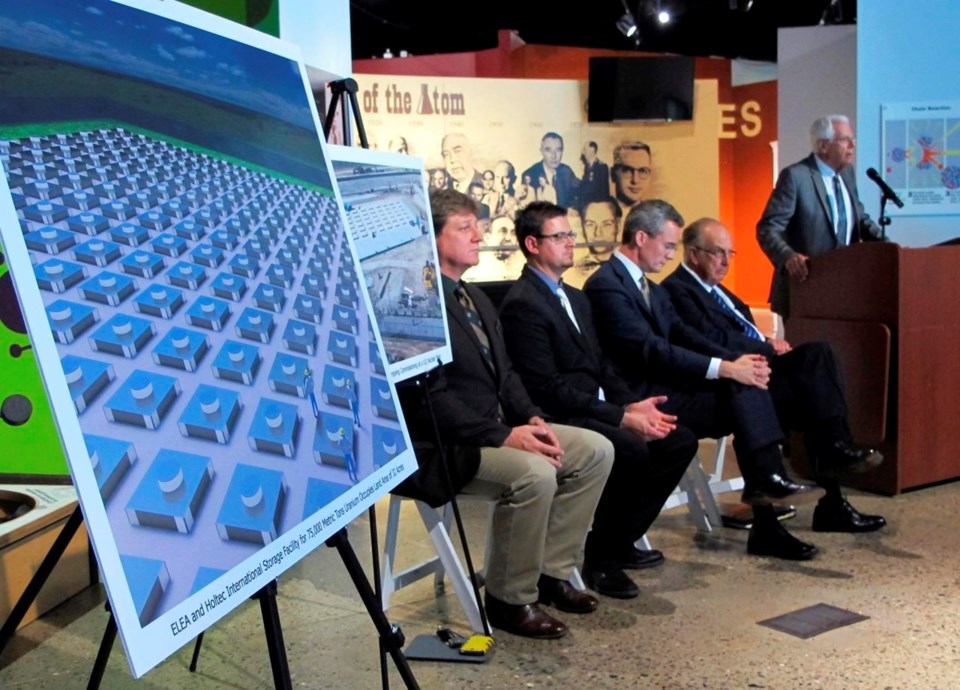ALBUQUERQUE, N.M. (AP) — The U.S. government has long struggled to find a permanent solution for storing or disposing of spent nuclear fuel from commercial nuclear power plants, and opposition to such a site is flaring up again as New Mexico lawmakers debate banning a facility without state consent.
The state's prospective ban cleared its first legislative hurdle Tuesday with approval from a key committee. Supporters acknowledge that the bill has a long road ahead, but it does have the backing of Democratic Gov. Michelle Lujan Grisham.
State Sen. Jeff Steinborn, the bill's sponsor, said momentum against New Mexico becoming a permanent dumping ground for the nation's nuclear waste — including spent fuel from commercial power plants — is growing and he's cautiously optimistic this is the year that the state takes a legislative stand.
Steinborn said consent should be mandatory and that the federal government should provide states with a significant financial incentive reflecting the risks associated with managing radioactive materials.
New Mexico and neighboring Texas have sued in federal court over two proposed multibillion-dollar interim storage facilities — one in southeastern New Mexico and the other in Andrews County, Texas.
“New Mexico has not been offered anything with this deal,” Steinborn said. “And even if we had, I don’t think any amount of money would convince me that it’s the right thing.”
The U.S. Nuclear Regulatory Commission approved a license for a facility in West Texas in 2021, and the agency plans to make a final decision as early as March on whether to grant a license for the planned storage complex in New Mexico. The two sites would be about 40 miles (64 kilometers) apart.
Environmental and nuclear watchdog groups have filed their own lawsuits, but a three-judge panel of the U.S. Court of Appeals for the District of Columbia on Wednesday dismissed all objections opposing the Texas project.
Federal appellate courts elsewhere have yet to rule on the state of Texas' claims, which focus on whether federal nuclear regulators have authority to license such a facility, or on New Mexico's claims that regulators did not do enough to vet plans by Holtec International.
The New Jersey-based company is seeking a 40-year license to build what it has described as a state-of-the-art complex near Carlsbad, which already is home to the federal government’s only underground repository for Cold War-era waste generated by decades of nuclear research and bomb-making.
Ed Mayer, program director of the planned facility, told state lawmakers during a hearing earlier this week that Holtec has an unblemished safety record and the probability of a severe accident happening while the spent fuel is transported via train from sites around the U.S. would be 1 in 10 trillion. Even then, he said, no radiological material would be released because the casks holding the fuel are robust.
Southeastern New Mexico officials testified that building the complex would bring jobs and diversify the region's economy, which is fueled now by oil and gas development that spans the Permian Basin.
However, commissioners in New Mexico two most populous counties — Bernalillo and Dona Ana — adopted resolutions this week opposing the transportation of spent fuel across county lines and the construction of an interim storage facility in the state.
While not necessarily opposed to nuclear power, Bernalillo County Commissioner Walt Benson said "the level of risk is too high and there’s a lack of information in terms of containing that risk.”
From the decommissioned nuclear plant near the San Onofre Beach in Southern California to plants that have powered communities on East Coast, spent fuel has been piling up for decades and elected officials in those communities want it shipped elsewhere.
U.S. Rep. Mike Levin, a California Democrat, is among those who have sought federal funding to restart the U.S. Department of Energy's consent-based process for locating places where the fuel would be welcomed.
“One of my top priorities since my first day in office has been moving the nuclear waste at San Onofre away from the region as quickly and safely as possible,” Levin said in September.
The Biden administration sweetened the pot this month, putting up $26 million for communities interested in studying potential interim storage sites. The deadline to apply is Jan. 31.
Despite opposition from environmentalists, Biden and his top energy officials have pointed to nuclear power as essential to achieving their goals of producing carbon-free electricity over the next decade.
According to the DOE, nuclear reactors across the country produce more than 2,000 metric tons of radioactive waste a year, with most of it remaining on-site because there’s nowhere else to put it. The federal government is paying to house the fuel, and the cost is expected to stretch into the tens of billions over the next decade, according to a review by independent government auditors.
Steinborn said the state of New Mexico's willingness to entertain spent fuel storage will hinge on the federal government's ability to identify and fund a permanent solution.
“They just need to change their approach rather than just shove it down the state’s throat without any assurances,” he said.
Susan Montoya Bryan, The Associated Press



